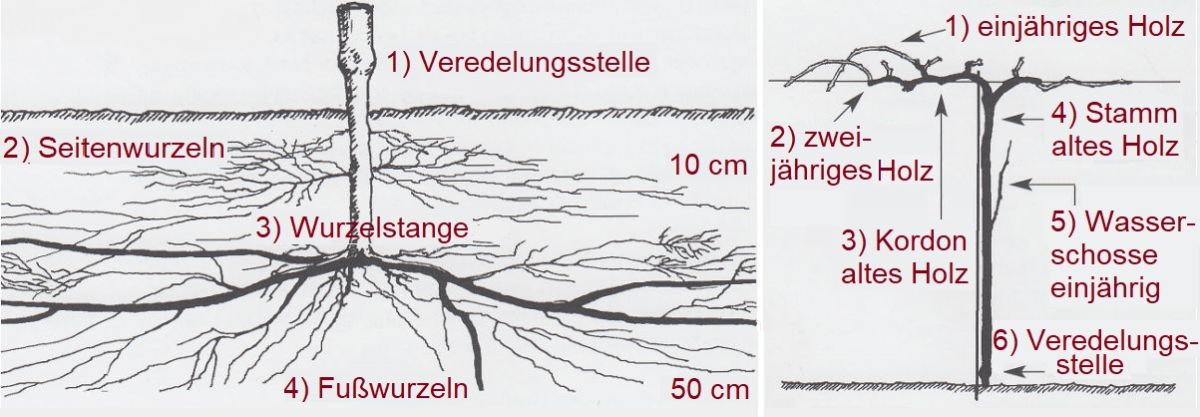Underlay & underlay vine
Term for the lower part or rootstock of a grafted vine that originates from a phylloxera-resistant American vine. During grafting, the upper part (scion) of European grape varieties of the species Vitis vinifera is grafted onto it. The main reason for such grafting is the low susceptibility or resistance of the roots of wild American varieties to the underground stages of phylloxera, or to the nodosities and tuberosities (growths) formed on the roots as a result of phylloxera infestation.

Lower part (root system): 1 = grafting point, 2 = lateral roots, 3 = root stem, 4 = foot roots
Upper part (scion): 1 = one-year-old wood, 2 = biennial wood, 3 = cordon of old wood, 4 = trunk of old wood, 5 = watershoots of one-year-old wood, 6 = grafting site
Quality criteria
With regard to suitability for viticulture, rootstock grape varieties must also fulfil further breeding requirements. These are low susceptibility to both types of mildew, low tendency to chlorosis, high resistance to bacteria and viruses, good wood structure and wood maturity, good adaptation (tolerance) to different and difficult soil types such as dry soil or limestone soil, good absorption of nutrients from the soil, as well as good grafting affinity to the grafted grape variety without promoting the coulure.
Good intergrowth of the two foreign tissues at the grafting site and the harmonious coordination of the growth characteristics of the grafted grape variety with the rootstock selected according to the soil type ensure good vigour and grape quality with consistently high yields from the vine.
Vine species for rootstocks
The majority of rootstocks used in European countries are descendants of crosses of the three American species Vitis berlandieri x Vitis riparia, Vitis riparia x Vitis rupestris and Vitis berlandieri x Vitis rupestris. The greatest contribution was made by the US botanist Thomas Volney Munson (1843-1913). A rootstock with complete phylloxera resistance, approved in 1989, was created by Dr Helmut Becker (1927-1990) from a cross of Vitis riparia x Vitis cinerea and named after the German oenologist Dr Carl Börner (1880-1953).
Suitability
Not every rootstock variety is equally suitable for the different soil types, site conditions, noble varieties and growth requirements. For this reason, there are official recommendations as to which rootstock harmonises best with which grape variety (top) on which soil and produces the required results.
The cuttings of most rootstock varieties root without any problems, but the cuttings of European Vitis vinifera still root best. Therefore, the European part of a grafted vine cutting should not be buried in the soil. Experience has shown that the rootstock varieties with crosses of Vitis cinerea var. helleri (old name Vitis berlandieri) or Vitis champinii root poorly, so the ends of the cuttings are coated with the growth hormone auxin to induce root formation.
Authorisation
Just like quality wine grape varieties, rootstock varieties are also authorised or classified by the state authorities (depending on the wine-growing region). Some (latent) vine diseases can be spread during grafting and cuttings propagation if plant material (rootstock or scion) infected with viruses or bacteria is used. The effects often only become visible in older canes. For this reason, the use of plant material that is as healthy and virus-free as possible is required by law in the EU. Proof must be provided by means of a standardised procedure (see under certification of vines).
grower
The development of special rootstocks began towards the end of the 19th century. Well-known grower are François Baco, Helmut Becker, Carl Börner, Maxime Cornu, Georges...
Voices of our members

Serious sources on the internet are rare - and Wine lexicon from wein.plus is one such source. When researching for my articles, I regularly consult the wein.plus encyclopaedia. There I get reliable and detailed information.
Thomas Götz
Weinberater, Weinblogger und Journalist; Schwendi